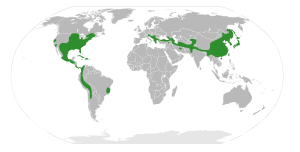Category:Juglandaceae
| Juglandaceae | |
|---|---|

| |
| Juglans regia | |
| Scientific classification | |
| Kingdom: | Plantae |
| Clade: | Angiosperms |
| Clade: | Eudicots |
| Clade: | Rosids |
| Order: | Fagales |
| Family: | Juglandaceae DC. ex Perleb[1] |
| Type genus | |
| Juglans | |
| Subfamilies | |
|
See text | |

| |
| The range of subfamily Engelhardioideae. | |

| |
| The range of subfamily Juglandoideae. | |
| Synonyms[2] | |
| |
The Juglandaceae are a family, known as the walnut family, of trees, or sometimes shrubs, in the order Fagales. Various members of this family are native to the Americas, Eurasia, and Southeast Asia.
The nine or ten genera in the family have a total of ca 50 species,[3], but the only genera known for their edible nuts are Juglans (the walnuts), and Carya (the hickories, including pecans). The Persian walnut, Juglans regia, is one of the major nut crops of the world. Walnut, hickory, and gaulin are also valuable timber trees.
Taxonomy

The known living genera are grouped into subfamilies, tribes, and subtribes as follows:[4]
- Subfamily Rhoipteleoideae Reveal
- Rhoiptelea Diels & Hand.-Mazz. 1932[5]
- Subfamily Engelhardioideae Iljinskaya 1990
- Alfaroa Standl. 1927—gaulin
- Engelhardia Lesch. ex Blume 1825–1826—cheo
- Oreomunnea Oerst. 1856
- Subfamily Juglandoideae Eaton 1836
- Tribe Platycaryeae Nakai 1933
- Platycarya Siebold & Zucc. 1843
- Tribe Juglandeae Rchb. 1832
- Subtribe Caryinae D.E. Stone & P. S. Manos 2001
- Carya Nutt. 1818—hickory and pecan
- Annamocarya A.Chev. 1941 (sometimes included in Carya)
- Subtribe Juglandinae D.E. Stone & P. S. Manos 2001
- Cyclocarya Iljinsk 1953—wheel wingnut
- Juglans L. 1753—walnut
- Pterocarya Kunth 1824—wingnut
- Subtribe Caryinae D.E. Stone & P. S. Manos 2001
- Tribe Platycaryeae Nakai 1933
Systematics
Modern molecular phylogenetics suggest the following relationships:[6]
|
| |||||||||||||||||||||||||||||||||||||||||||||||||||||||||||||
Fruits

Some fruits are borderline and difficult to categorize. Hickory nuts (Carya) and walnuts (Juglans) grow within an outer husk; these fruits are sometimes considered to be drupes or drupaceous nuts, rather than true botanical nuts. "Tryma" is a specialized term for such nut-like drupes.[7][8]
The fruits of the Juglandaceae are often confused with drupes but are accessory fruit because the outer covering of the fruit is technically an involucre and thus not morphologically part of the carpel; this means it can not be a drupe but is instead a drupe-like nut. These odd nuts fall into two different types: in the walnut genus (Juglans), it is a pseudodrupe and in the hickory genus (Carya), it is a tryma.[9]
References
- ↑ Angiosperm Phylogeny Group (2009). "An update of the Angiosperm Phylogeny Group classification for the orders and families of flowering plants: APG III" (PDF). Botanical Journal of the Linnean Society. 161 (2): 105–121. doi:10.1111/j.1095-8339.2009.00996.x. Retrieved 2013-07-06.
- ↑ "Family: Juglandaceae DC. ex Perleb, nom. cons". Germplasm Resources Information Network. United States Department of Agriculture. 2003-01-17. Retrieved 2011-11-17.
- ↑ Christenhusz, M. J. M.; Byng, J. W. (2016). "The number of known plants species in the world and its annual increase". Phytotaxa. Magnolia Press. 261 (3): 201–217. doi:10.11646/phytotaxa.261.3.1.
- ↑ Manos, P. S.; D. E. Stone (2001). "Evolution, phylogeny and systematics of the Juglandaceae". Annals of the Missouri Botanical Garden. 88: 231–269. doi:10.2307/2666226.
- ↑ "GRIN Genera of Juglandaceae". Germplasm Resources Information Network. United States Department of Agriculture. Retrieved 2011-11-17.
- ↑ Xiang X-G, Wang W, Li R-Q, Lin L, Liu Y, Zhou Z-K, Li Z-Y, Chen Z-D. (2014). "Large-scale phylogenetic analyses reveal fagalean diversification promoted by the interplay of diaspores and environments in the Paleogene". Perspectives in Plant Ecology, Evolution and Systematics. 16: 101–110. doi:10.1016/j.ppees.2014.03.001.
- ↑ Armstrong, W.P. "Identification Of Major Fruit Types". Wayne's World. Archived from the original on 2011-11-20. Retrieved 2011-11-17.
- ↑ Armstrong, W.P. (2009-03-15). "Fruits Called Nuts". Wayne's World. Archived from the original on 2012-04-19. Retrieved 2011-11-17.
- ↑ John Derek Bewley, Michael Black, Peter Halmer (2006) The Encyclopedia of Seeds: Science, Technology And Uses
External links
| Wikisource has the text of the 1920 Encyclopedia Americana article Juglandacæ. |
Acknowledgements
This article uses material from the Wikipedia article Juglandaceae, which is released under the Creative Commons Attribution-Share-Alike License 3.0.
Pages in category "Juglandaceae"
The following 17 pages are in this category, out of 17 total.